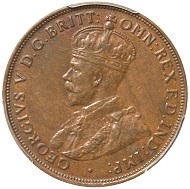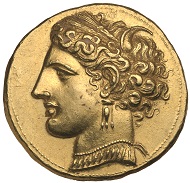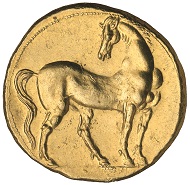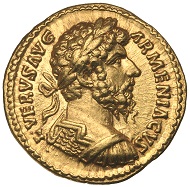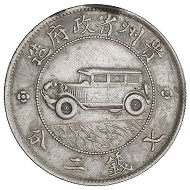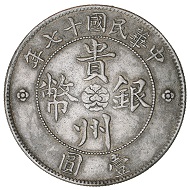25-07-2016 – 27-07-2016
Noble Numismatic Sale 112
Important Australian & World Coins, Medals, Tokens & Banknotes
Noble Numismatics auction Sale 112 is to be held Monday, Tuesday, Wednesday and Thursday 25th- 28th July from 9:30am each day in the Dixson Room, State Library NSW, featuring, among a total of 378 lots, the George Fenton Collection of Australian Commonwealth pre-decimal coins, 1910-1964.
Lot 234: George V, 1930 penny, Indian die. In a slab by PCGS as AU50, population two, none finer. Estimate: $ 75,000.
Every coin has been graded by PCGS and their descriptions include adjectival descriptions by the cataloguer. Jim Noble as well as the numerical grading assigned by PCGS. In addition, population reports from PCGS have been provided by Scott Waterman of the Universal Coin Company. A separate catalogue has been printed with all 378 coins illustrated and offered as individual lots. George Fenton, the founder and principal of Paladin Energy in Texas, has spared no expense or effort to assemble this outstanding collection over the last fifteen years. The collection was, for a time, the number one PCGS Registry set of Australian pre-decimal coins. In recent years two other collections have achieved this level of importance, both collectors being residents of Australia, and one has since disposed of his collection privately, the other is still an active collector.
The auction of the collection with estimates totaling less than half the original cost presents collectors with an outstanding opportunity to elevate their collections to top drawer status. It also presents a unique opportunity for dealers and guide book authors to determine the current market value of high grade pre-decimal coins. The collection is being offered as the tenth session of the sale on Wednesday 27th July, commencing at 7:30pm.
Highlights of the Fenton Collection include a nearly uncirculated 1922/1 overdate threepence (PCGS AU58, finest known) estimated at $75,000, a 1930 penny (PCGS AU50) estimated at $75,000, a 1920 plain penny, full mint red and ex Benchmark Collection (lot 80) estimated at $60,000, being the finest known and an uncirculated 1915 florin (PCGS MS64) estimated at $15,000. Probably the finest known 1933/2 overdate penny (PCGS MS64RD) is estimated at $20,000 owing to its full original mint red appearance.
In the first evening session there are Proclamation and Colonial coins such as a NSW holey dollar, 1813 (ex Tom Hanley Collection) estimated at $70,000, and a top grade holey dollar, 1813, ex Wodak, Gartner and Jewell collections, two choice New South Wales dumps, estimated at $40,000 each, Australian gold coins headed up by Adelaide pounds, one in good extremely fine condition estimated at $30,000, a specimen 1872 Melbourne shield sovereign and a proof-like 1885 Melbourne St. George reverse sovereign, a series of choice Imperial half sovereigns, a good series of early proofs in the Australian Commonwealth series including a 1916 Melbourne set with original plush blue leatherette presentation case, a full 1938 set including the crown, a 1951 London Mint proof sixpence and threepence, Perth Mint proof halfpennies 1951 and 1953, a proof 1924 halfpenny, a proof 1928 penny with much mint red, a proof penny and half penny 1943 pair from the Bombay Mint, and a proof penny and halfpenny 1935 pair with nearly full mint red. There is also a beautifully toned mint state 1921 pattern square penny by D. Richardson from the Governor of Victoria.
Lot 5212: Zeugitania, Carthage, (possibly Siculo-Punic), (c.264-260 B.C.), the time of the first Punic War, gold trihemistater or Attic tridrachm. Estimate: $ 20,000.
Another highlight collection features in the Ancient coins section with the offering of the ‘Hannibal’ Collection of Carthaginian coins including the duodecadrachm (twelve drachm) and the hexadrachm (six drachm) rarities in silver, two Dido tetradrachms (one ex Count Torremuzza, a Collection in about 1780) and a gold tri-hemi (one and a half) stater.
Lot 5159: Lucius Verus, (A.D. 161-169), gold aureus, issued 164, Rome mint. Estimate: $ 18,000.
Other ancient coins include a series of Roman aureii in high grade of emperors Hadrian, Lucius Verus, Severus Alexander, Maximian, Diocletian and Julian II.
British coins include a collection of farthings from James I to present, including three patterns of Queen Anne. Gold issues include a proof half guinea of 1787 and a mint state first type sovereign, 1825. Silver coins include a milled shilling of Elizabeth I (1562), a choice Cromwell shilling 1658 being sold with an original signature of Cromwell, a good extremely fine George II crown 1743, and a plain edge proof Gothic crown 1847.
The World Gold coins include a South African ZAR veld pond 1902 acquired by a bank teller in Pilgrim’s Rest in the early 1920s and a Czechoslovakia ten ducats, 1929.
Lot 5378: China, Republic, Kweichow Province, silver auto dollar, issued year 17, 1928, issued to commemorate first road in Kweichow Province. Estimate: $ 2,500.
World Silver and Bronze coins include a series of Chinese silver dollars collected by the late Robert G. Kaldor (1921-1981) with Birds over Junk dollar (1932) and a Kweichow automobile dollar (1928) as the stand-out coins. From another estate there is a run of South East Asia Trade dollars and Hong Kong dollars 1867, 1868 two varieties of each, scores of pieces of eight or eight reales plus a series of Straits Settlements silver and bronze.
In paper currency there is a good range of world notes to suit all collectors including specialized collections of Japanese Invasion Money (J.I.M). In an old estate collected pre World War I and into the 1940s comes a series of Chinese notes that includes a run of four consecutive plus a fifth note one removed of the ten dollars of the National Bank of China, 1921 issue, a note that is priced in the Pick World Paper Money Catalogue at USD19,500 in extremely fine condition. Other strengths in the world notes are Pacific area issues of Fiji, Tonga, Samoa and French Indo China. In modern notes there is the world’s largest sized banknote, the 1998 Philippines commemorative 100,000 peso issue with certificate. This limited-issue rarity carries an estimate of $15,000.
The New Zealand banknotes feature a selection of the Warren Palmer (of Southland) Collection including several trading bank notes, led by a National Bank uniform issue 1st June 1926 ten pounds, est $4,000 and a Union Bank ten shillings, 1st March 1920, est $4,000. The key note in the Reserve Bank series is a very fine Lefeaux fifty pounds, estimated at $12,000.
Australian notes include a range of private bank issues, commencing with copper printing plates by Samuel Clayton for the Read and Bethune Tasmania promissory notes. In Commonwealth pre-decimal issues there is a National Bank superscribed one pound 1910, a high grade Collins/Allen one pound 1913 (R.18c) conservatively estimated at $10,000, and all the star notes with the ten shillings, Armitage/McFarlane being nearly extremely fine. There is a series of decimal specimen notes, including a pair of Johnston/Stone paper one hundred dollars with presentation letter.
A highlight of Australian Historical Medals is the unique striking in gold of the Australian Numismatic Society’s Captain Cook bicentenary medal of 1970 formerly in the Tom Hanley Collection. From the late Dr. Bill Mira’s Collection is a display board of Papua New Guinea badges, many illustrated in his book ‘From Cowrie to Kina’ published by Spink Australia, Sydney, 1986.
The highlight of the Military Medal section is a World War I trio to submariner and Leading Seaman Gordon Clarence Corbould of the AE1. This is the only trio to appear on the auction market so it should attract attention from museums and collectors. The submarine AE1 disappeared without trace after participating in the capture of German New Guinea and was the RAN’s first major loss of World War I. There is also a group of four to a survivor of the sinking of the Australian Hospital Ship ‘Centaur’, a World War II war crime committed when a Japanese submarine torpedoed a clearly marked hospital ship carrying civilian passengers including nurses and medical personnel en route to New Guinea with only 64 of the 332 on board surviving.
Please find the complete online auction catalogue here.
For a PDF version of the catalogue please click here.




